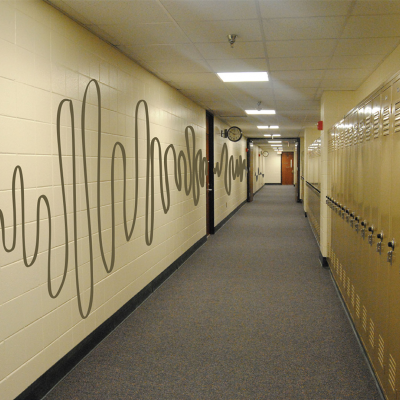
This project developed after spending too much time in an ugly building.
All buildings have little quirks. East Duke has no male bathrooms. Smith Warehouse’s walls don’t extend all the way to the ceiling. But when it comes to Biddle, it is not quirky, it is just mind-numbingly dull.
Now, don’t get me wrong. The central lobby on the bottom floor is nice. I have spent many a day gazing absentmindedly at the flowing water or up at the round skylights, but that offers little respite for the long hours spend in the windowless, colorless practice rooms or walking around the long subterranean hallways.
The contrast between the nature of the activity in the building and the architecture grated my nerves. The music department is small but vibrant. Famous artists and aspiring musicians alike live, work and produce in Biddle. Yet this building confines rather than encouraging creative activity. The long dull colorless hallways, the fluorescent lighting, the pockmarked ceiling tiles, seem more at home in an office building than a music building.
Artist's statement:
I believe that buildings can have a profound effect on how we feel, how we act, and what we believe. Through this project, I want to help people become aware of the spaces we inhabit. How do they shape us? How do they change us? At least for me, there are many architectural spaces that I spend a large amount of time and energy in, but when I graduate, these memories of the people I met, the frustrations and excitement will leave with me. Through this project, I wanted to encourage people to not only recognize the space around them but also take ownership of it. By inscribing our memories, our dreams, our voices on the walls (literally and virtually), I hoped to get people to think about their time and experience at Duke as mediated by buildings. How has Cameron shaped your understanding of Duke? How has the Chapel influenced you? I don’t expect everyone to have dreams of altering the architecture around them through sculptures or prints. If you do have plans, that is great! However, I believe by taking the time to reflect and adding our own marks, words, and stories to the walls, we can add an additional layer, an additional dimension of memory to our buildings. Everybody has a story to tell and no story is too small or too insignificant. These memories shape how we perceived and understand Duke. This project attempts to collect some of these fragments of memory, the voices, and the drawings of different people that were touched by these spaces. As a graduating senior, I want to gather some of these memories so they aren’t lost. It’s impossible to capture everything, but by allowing people to write on the wall, we can leave something behind, something to say that we were here and this was our Duke.





